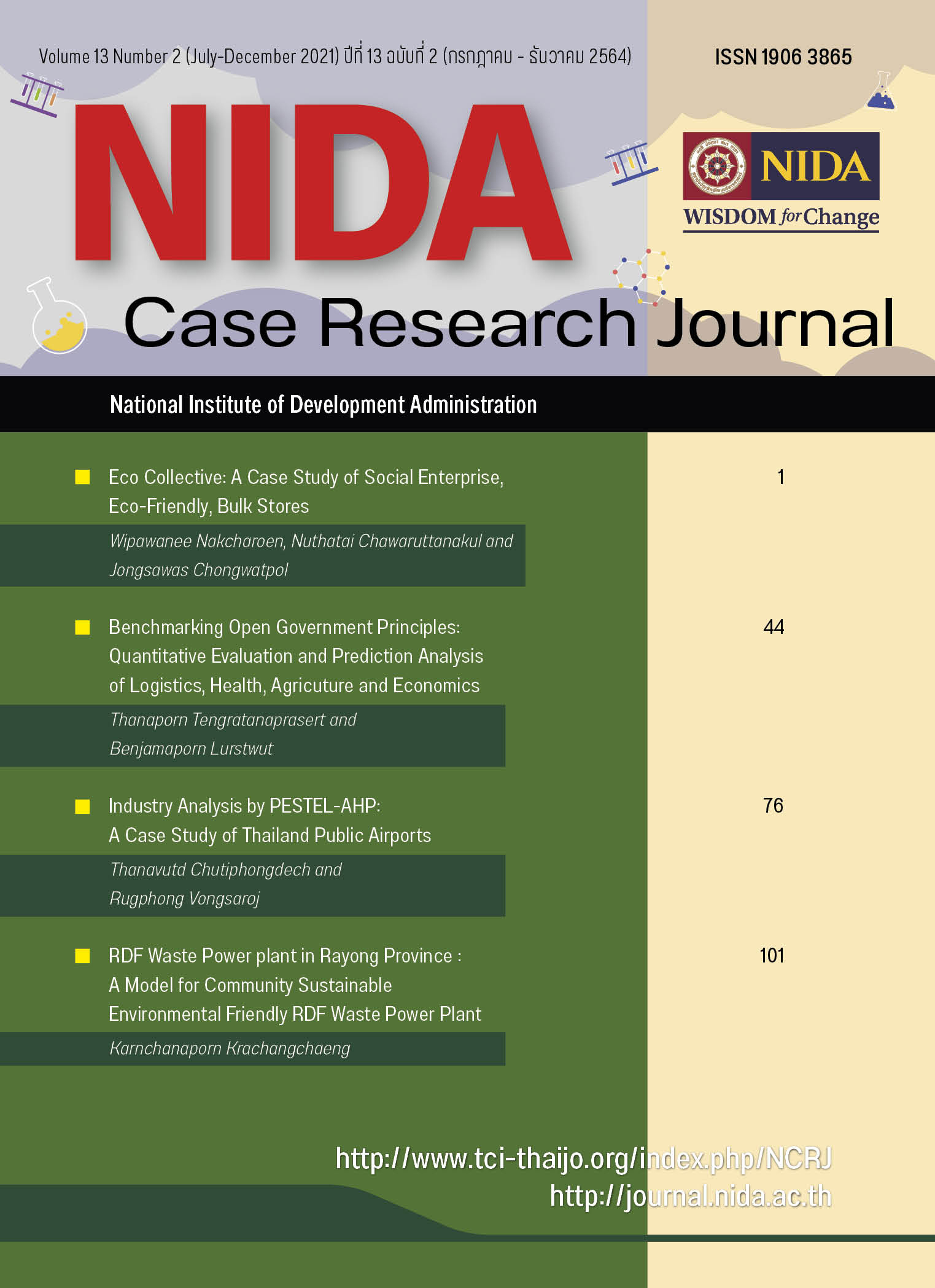การวิเคราะห์อุตสาหกรรมด้วย PESTEL-AHP: กรณีศึกษาสนามบินของรัฐในประเทศไทย
Main Article Content
บทคัดย่อ
บทความวิจัยนี้มีวัตถุประสงค์ในการประยุกต์ใช้ Analytical Hierarchy Process (AHP) ควบคู่กับการวิเคราะห์ด้วย PESTEL เพื่อวิเคราะห์อุตสาหกรรมในเชิงปริมาณและนำเสนอข้อเสนอแนะเชิงนโยบาย การศึกษาในครั้งนี้อาศัยสนามบินของรัฐซึ่งเป็นสนามบินท้องถิ่นและสนามบินภูมิภาคภายใต้การดูแลของกรมท่าอากาศยานเป็นกรณีศึกษา ผลการศึกษาพบว่า การถ่วงน้ำหนักค่าความสำคัญของตัวแปร PESTEL ด้วยค่าคะแนนที่เก็บจากกลุ่มผู้เชี่ยวชาญด้านสนามบินด้วยวิธี PESTEL-AHP ทำให้ พระราชบัญญัติการเดินอากาศ (ฉบับที่ 14) พ.ศ. 2562 เป็นตัวแปรด้านกฎหมายที่มีอิทธิพลต่อการดำเนินงานของสนามบินของรัฐมากที่สุด หรือคิดเป็นร้อยละ 28 เมื่อเปรียบเทียบกับตัวแปร PESTEL อื่น ๆ ในขณะที่ตัวแปรนโยบายยุทธศาสตร์ชาติ และตัวแปรแนวโน้มด้านการเปลี่ยนแปลงทางดิจิตัลในสนามบินมีบทบาทในการส่งผลกระทบต่ออุตสาหกรรมคิดเป็นร้อยละ 22 และ 21 ตามลำดับ ข้อเสนอแนะเชิงนโยบายสำหรับการพัฒนาสนามบินของรัฐซึ่งได้มาจากการวิเคราะห์อุตสาหกรรมอยู่ในส่วนสุดท้ายของบทความ
Article Details

This work is licensed under a Creative Commons Attribution-NonCommercial-NoDerivatives 4.0 International License.
References
Adler, N., Ülkü, T., & Yazhemsky, E. (2013). Small regional airport sustainability: Lessons from benchmarking. Journal of Air Transport Management, 33, 22-31.
Aguilar, F. J. (1967). Scanning the business environment. Macmillan.
Airport Council International. (2017). Airport digital transformation best practice . ACI.
Baglin, C. (2012). Airport climate adaptation and resilience a synthesis of airport practice. National Academy of Sciences.
Bain, J. S. (1959). Industrial organization. John Wiley and Son.
Bell, G. G., & Rochford, L. (2016). Rediscovering SWOT’s integrative nature: A new understanding of an old framework. The International Journal of Management Education, 14(3), 310-326.
Bogicevic, V., Bujisic, M., Bilgihan, A., Yang, W., & Cobanoglu, C. (2017). The impact of traveler-focused airport technology on traveler satisfaction. Technological Forecasting and Social Change, 123, 351-361.
Button, K., Doh, S., & Yuan, J. (2010). The role of small airports in economic development. Journal of Airport Management, 4(2), 125-136.
Carlton, D. W., & Perloff, J. M. (2015). Modern industrial organization (4th Ed.). Pearson.
Chutiphongdech, T. (2020). Airport technical efficiency and business model innovations: A case of local and regional airports in Thailand [Doctoral disertation, National Institute of Development Administration].
Chutiphongdech, T. (2021). Airport technical efficiency and business model innovations: A case of local and regional airports in Thailand. European Journal of Tourism Research, 28, 1-6.
Chutiphongdech, T., & Vongsaroj, R. (2022a). Critical components of airport business model framework: Evidence from Thailand. Sustainability, 14(4), 8347.
Chutiphongdech, T., & Vongsaroj, R. (2022b). The success behind the world’s best airport: The rise of Changi. Asia Social Issues, 15(1), 1-15.
Davis, R., & Duhaime, I. M. (1992). Diversification, vertical integration, and industry analysis: New perspectives and measurement. Strategic Management Journal, 13(7), 511-524.
De Neufville, R., & Odoni, A. (2013). Airport systems planning, design and management (2nd Ed.). McGraw Hills.
Görener, A., Toker, K., & Ulucay, K. (2012). Application of combined SWOT and AHP: A case study for a manufacturing firm. Procedia-Social and Behavioral Sciences, 58, 1525-1534.
Graham, A. (2005). Airport benchmarking: A review of the current situation. Benchmarking: An International Journal, 12(2), 99-111.
Graham, A. (2018). Managing airports: An international perspective. Routledge.
Helms, M. M., & Nixon, J. (2010). Exploring SWOT analysis–where are we now? A review of academic research from the last decade. Journal of Strategy and Management, 3(3), 215-251.
Hill, T., & Westbrook, R. (1997). SWOT analysis: It's time for a product recall. Long Range Planning, 30(1), 46-52.
International Air Transport Association. (2019). The impact of climate change on aviation. Retrieved from https://www.iata.org/contentassets/0772118eec2e40bbba472b862e4f45ec/sfo2019-day3-climate-change.pdf
Kampanje, B. (2014). PESTEL analysis of Malawi's non-life insurance industry. African Journal of Economic and Management Studies, 5(1). https://doi.org/10.1108/AJEMS-01-2013-0002
Lee, S., & Walsh, P. (2011). SWOT and AHP hybrid model for sport marketing outsourcing using a case of intercollegiate sport. Sport Management Review, 14(4), 361-369.
Mason, E. S. (1939). Price and production policies of large-scale enterprise. The American Economic Review, 29(1), 61-74.
Mason, E. S. (1949). The current status of the monopoly problem in the United States. Harvard Law Review, 62(8), 1265-1285.
Merkert, R., Odeck, J., Brathen, S., & Pagliari, R. (2012). A review of different benchmarking methods in the context of regional airports. Transport Reviews, 32(3), 379-395.
Ministry of Industry. (2017). Thailand 4.0 Industry Development Strategy (BE 2560-2579). Ministry of Industry.
Nikomborirak, D. (2004). Industrial economics. Thammasat Economic Journal, 22(4), 109-126.
Oey, E., & Nitihardjo, E. C. (2016). Selecting regional postponement centre using PESTLE-AHP-TOPSIS methodology: A case study in a pharmaceutical company. Global Business Review, 17(5), 1250-1265.
Office of the National Economic and Social Development Council. (2018). The National Strategy (2018-2037). NESDC.
Pan, W., Chen, L., & Zhan, W. (2019). PESTEL analysis of construction productivity enhancement strategies: A case study of three economies. Journal of Management in Engineering, 35(1), 05018013. https://doi.org/doi:10.1061/(ASCE)ME.1943-5479.0000662
Porter, M. E. (2001). Strategy and the Internet. Harvard Business Review, 79(2), 63-78.
Puempel, H., & Williams, P. D. (2016). The impacts of climate change on aviation: Scientific challenges and adaptation pathways. In ICAO Environmental report 2016: On board a sustainable future (pp. 205-207). ICAO.
Saaty, T. L. (1990). How to make a decision: The analytic hierarchy process. European Journal of Operational Research, 48(1), 9-26.
Saaty, T. L. (2008). Decision making with the analytic hierarchy process. International Journal of Services Sciences, 1(1), 83-98.
Song, J., Sun, Y., & Jin, L. (2017). PESTEL analysis of the development of the waste-to-energy incineration industry in China. Renewable Sustainable Energy Reviews, 80, 276-289.
Srdjevic, Z., Bajcetic, R., & Srdjevic, B. (2012). Identifying the criteria set for multicriteria decision making based on SWOT/PESTLE Analysis: A case study of reconstructing a water intake structure. Water Resources Management, 26(12), 3379-3393.
https://doi.org/10.1007/s11269-012-0077-2
TAT Interlligence Center. (2018). The Compass. Retrieved from http://marketingdb.tat.or.th/documents/10181/58221/Compass-Q4-2561.pdf/c2b9b2b4-f226-4dc5-aa3c-d804b55ddc1b
Thakur, V. (2021). Framework for PESTEL dimensions of sustainable healthcare waste management: Learnings from COVID-19 outbreak. Journal of Cleaner Production, 287, 125562. https://doi.org/https://doi.org/10.1016/j.jclepro.2020.125562
Thompson, A. A., Peteraf, M. A., Gamble, J. E., & Strickland Iii, A. J. (2014). Crafting and executing strategy : The quest for competitive advantage : Concepts and cases (19th Ed.). McGraw-Hill Education.
Tsangas, M., Jeguirim, M., Limousy, L., & Zorpas, A. (2019). The application of Analytical Hierarchy Process in combination with PESTEL-SWOT analysis to assess the hydrocarbons sector in Cyprus. Energies, 12(5), 1-17.
Wattanacharoensil, W., Schuckert, M., & Graham, A. (2016). An airport experience framework from a tourism perspective. Transport Reviews, 36(3), 318-340.
Yüksel, I. (2012). Developing a multi-criteria decision making model for PESTEL analysis. International Journal of Business and Management, 7(24), 52-66.
Zaharia, S. E., & Pietreanu, C. V. (2018). Challenges in airport digital transformation. Transportation Research Procedia, 35, 90-99. https://doi.org/https://doi.org/10.1016/j.trpro.2018.12.016

